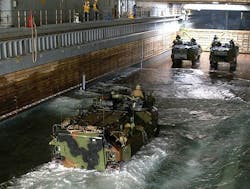Officials of the Naval Air Systems Command at Patuxent River Naval Air Station, Md., announced the contracts for the Navy Strike Planning and Execution Systems program office, also known as PMA-281.
The nine companies will compete for individual task orders over the next five years that involve software development, test and evaluation, maintenance, integration, training, and fielding of Strike Planning and Execution Systems.
The NINE companies winning contracts are:
BAE Systems Information Solutions Inc. in San Diego;
DCS Corp. in Alexandria, Va.;
Dynetics Inc. in Huntsville, Ala.;
Progeny Systems Corp. in Manassas, Va.;
the Raytheon Co. Intelligence, Information and Services segment in Dulles, Va.;
Tapestry Solutions Inc., a Boeing Co., in San Diego;
the Northrop Grumman Corp. Information Systems segment in Herndon, Va.;
QinetiQ North America Inc. in Reston, Va.; and
the Lockheed Martin Corp. Information Systems and Global Solutions segment in King of Prussia, Pa.
Related: Displays, graphics, and data links for unmanned vehicle command and control
The Navy's Strike Planning and Execution Systems program office is responsible for the acquisition and life cycle management of mission planning, control system, and execution tools.
Among these planning tools are the Electronic Knee Board (EKB); Joint Mission Planning System (JMPS); Joint Mission Planning System- Expeditionary (JMPS-E); Theater Mission Planning Center (TMPC); Air Wing Ship Integration (AWSI); and Unmanned System Common Control System (CCS).
The Electronic Knee Board provides aircraft pilots with flight information charts, instrument approach plates, tactical charts, imagery, and other digital products.
The Joint Mission Planning System provides information, automated tools, and decision aids to plan aircraft, weapon, and sensor missions rapidly and accurately. The system loads mission data into aircraft, weapons and avionics systems.
The Joint Mission Planning System- Expeditionary is a Web-based mission planning system for the expeditionary strike group, marine expeditionary unit, and amphibious squadron. It provides synchronizes mission execution, helps communicate a commander’s intent, enhances crisis action planning efficiency.
Related: DARPA to brief industry on software tools to plan air battles with manned aircraft and UAVs
The Theater Mission Planning Center is the mission planning segment of the Tomahawk cruise missile that provides precision targeting, route planning, mission distribution, and strike management of Tomahawk cruise missile missions from sites located ashore and afloat. TMPC optimizes all aspects of the Tomahawk missile mission to engage a target.
Air Wing Ship Integration consists of four programs: Digital Camera Receiving Station (DCRS), Naval Strike Warfare Planning Center (NSWPC), Integrated Strike Planning and Execution (ISP&E) and Carrier Ready Room Transformational Technologies Upgrade.
The Unmanned System Common Control System has a common framework, user interface, and components that can be integrated and tested on a variety of emerging or legacy platforms. The system will provide an open software architecture that is agile and scalable to support evolving requirements.
For more information contact Naval Air Systems Command online at www.navair.navy.mil.



